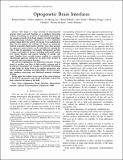| dc.contributor.author | Pashaie, Ramin | |
| dc.contributor.author | Anikeeva, Polina Olegovna | |
| dc.contributor.author | Lee, Jin Hyung | |
| dc.contributor.author | Prakash, Rohit | |
| dc.contributor.author | Yizhar, Ofer | |
| dc.contributor.author | Prigge, Matthias | |
| dc.contributor.author | Chander, Divya | |
| dc.contributor.author | Richner, Thomas J. | |
| dc.contributor.author | Williams, Justin | |
| dc.date.accessioned | 2015-01-22T21:06:58Z | |
| dc.date.available | 2015-01-22T21:06:58Z | |
| dc.date.issued | 2014-04 | |
| dc.date.submitted | 2013-12 | |
| dc.identifier.issn | 1937-3333 | |
| dc.identifier.issn | 1941-1189 | |
| dc.identifier.uri | http://hdl.handle.net/1721.1/93158 | |
| dc.description.abstract | The brain is a large network of interconnected neurons where each cell functions as a nonlinear processing element. Unraveling the mysteries of information processing in the complex networks of the brain requires versatile neurostimulation and imaging techniques. Optogenetics is a new stimulation method which allows the activity of neurons to be modulated by light. For this purpose, the cell-types of interest are genetically targeted to produce light-sensitive proteins. Once these proteins are expressed, neural activity can be controlled by exposing the cells to light of appropriate wavelengths. Optogenetics provides a unique combination of features, including multimodal control over neural function and genetic targeting of specific cell-types. Together, these versatile features combine to a powerful experimental approach, suitable for the study of the circuitry of psychiatric and neurological disorders. The advent of optogenetics was followed by extensive research aimed to produce new lines of light-sensitive proteins and to develop new technologies: for example, to control the distribution of light inside the brain tissue or to combine optogenetics with other modalities including electrophysiology, electrocorticography, nonlinear microscopy, and functional magnetic resonance imaging. In this paper, the authors review some of the recent advances in the field of optogenetics and related technologies and provide their vision for the future of the field. | en_US |
| dc.description.sponsorship | United States. Defense Advanced Research Projects Agency (Space and Naval Warfare Systems Center, Pacific Grant/Contract No. N66001-12-C-4025) | en_US |
| dc.description.sponsorship | University of Wisconsin--Madison (Research growth initiative; grant 101X254) | en_US |
| dc.description.sponsorship | University of Wisconsin--Madison (Research growth initiative; grant 101X172) | en_US |
| dc.description.sponsorship | University of Wisconsin--Madison (Research growth initiative; grant 101X213) | en_US |
| dc.description.sponsorship | National Science Foundation (U.S.) (MRSEC DMR-0819762) | en_US |
| dc.description.sponsorship | National Science Foundation (U.S.) (NSF CAREER CBET-1253890) | en_US |
| dc.description.sponsorship | National Institutes of Health (U.S.) (NIH/NIBIB R00 Award (4R00EB008738) | en_US |
| dc.description.sponsorship | National Institutes of Health (U.S.) (NIH Director’s New Innovator award (1-DP2-OD002989)) | en_US |
| dc.description.sponsorship | Okawa Foundation (Research Grant Award) | en_US |
| dc.description.sponsorship | National Institutes of Health (U.S.) (NIH Director’s New Innovator Award (1DP2OD007265)) | en_US |
| dc.description.sponsorship | National Science Foundation (U.S.) (NSF CAREER Award (1056008) | en_US |
| dc.description.sponsorship | Alfred P. Sloan Foundation (Fellowship) | en_US |
| dc.description.sponsorship | Human Frontier Science Program (Strasbourg, France) (Grant No. 1351/12) | en_US |
| dc.description.sponsorship | Israeli Centers of Research Excellence (I-CORE grant, program 51/11) | en_US |
| dc.description.sponsorship | MINERVA Foundation (Germany) | en_US |
| dc.language.iso | en_US | |
| dc.publisher | Institute of Electrical and Electronics Engineers (IEEE) | en_US |
| dc.relation.isversionof | http://dx.doi.org/10.1109/RBME.2013.2294796 | en_US |
| dc.rights | Creative Commons Attribution-Noncommercial-Share Alike | en_US |
| dc.rights.uri | http://creativecommons.org/licenses/by-nc-sa/4.0/ | en_US |
| dc.source | Prof. Anikeeva via Angie Locknar | en_US |
| dc.title | Optogenetic Brain Interfaces | en_US |
| dc.type | Article | en_US |
| dc.identifier.citation | Pashaie, Ramin, Polina Anikeeva, Jin Hyung Lee, Rohit Prakash, Ofer Yizhar, Matthias Prigge, Divya Chander, Thomas J. Richner, and Justin Williams. “Optogenetic Brain Interfaces.” IEEE Rev. Biomed. Eng. 7 (2014): 3–30. | en_US |
| dc.contributor.department | Massachusetts Institute of Technology. Department of Materials Science and Engineering | en_US |
| dc.contributor.approver | Anikeeva, Polina Olegovna | en_US |
| dc.contributor.mitauthor | Anikeeva, Polina Olegovna | en_US |
| dc.relation.journal | IEEE Reviews in Biomedical Engineering | en_US |
| dc.eprint.version | Author's final manuscript | en_US |
| dc.type.uri | http://purl.org/eprint/type/JournalArticle | en_US |
| eprint.status | http://purl.org/eprint/status/PeerReviewed | en_US |
| dspace.orderedauthors | Pashaie, Ramin; Anikeeva, Polina; Jin Hyung Lee, Polina; Prakash, Rohit; Yizhar, Ofer; Prigge, Matthias; Chander, Divya; Richner, Thomas J.; Williams, Justin | en_US |
| dc.identifier.orcid | https://orcid.org/0000-0001-6495-5197 | |
| mit.license | OPEN_ACCESS_POLICY | en_US |
| mit.metadata.status | Complete | |
